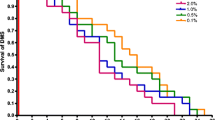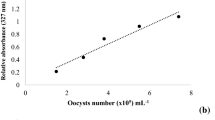Abstract
Preservation of the exogenous oöcyst stage of coccidian parasites (phylum Apicomplexa N.D. Levine, 1970) as type-specimens of newly described species has long been problematical. Conventional fixatives have proved unsatisfactory, and compromises such as embedding oöcysts in resin or photographing them are not entirely appropriate for various reasons. As an alternative, chilled potassium dichromate solution (normally used in the laboratory to prevent putrefaction of temporary preparations of live oöcysts) has been tested as a long-term preservative of sporulated oöcysts of Eimeria brunetti P.P. Levine, 1942, E. maxima Tyzzer, 1929, E. mitis Tyzzer, 1929, E. necatrix Johnson, 1930, E. praecox Johnson, 1930 and E. tenella (Railliet & Lucet, 1891) (suborder Eimeriorina Léger, 1911; family Eimeriidae Minchin, 1903). Oöcysts from faeces of chickens Gallus gallus (Linnaeus) were placed in 2.5% w/v aqueous potassium dichromate solution (PDS) and stored in the dark at 4 ± 2°C. After 23 years in storage, oöcysts of each species were administered orally to chickens and failed to initiate infections, indicating that the oöcysts were dead. Nevertheless, after about 24 years, DNA was still recoverable from the oöcysts, and the original species identifications made by classic parasitological methods were confirmed by polymerase chain reaction assays. Furthermore, after almost 25 years, microscopical examination revealed that the walls and internal structures remained well preserved in 83–98% of the oöcysts of the six species investigated. Hence, PDS is potentially suitable for the long-term preservation of sporulated coccidian oöcysts as type-specimens for taxonomic purposes. The samples used in this study are now in the care of the Natural History Museum, London, UK. It is recommended that they be monitored in like manner, by suitably qualified scientists, at intervals of about 5 years to assess their state of preservation and the recoverability of DNA. Enough material is available to monitor it until it is at least 100 years old.


Similar content being viewed by others
References
Bandoni, S. M., & Duszynski, D. W. (1988). A plea for improved presentation of type material for coccidia. Journal of Parasitology, 74, 519–523.
Dickinson, E. M. (1946). A factor in delayed production of Eimeria tenella oocysts. Poultry Science, 25, 391–392.
Duszynski, D. W., & Gardner, S. L. (1991). Fixing coccidian oocysts is not an adequate solution to the problem of preserving protozoan type material. Journal of Parasitology, 77, 52–57.
Duszynski, D. W., & Wilber, P. G. (1997). A guideline for the preparation of species descriptions in the Eimeriidae. Journal of Parasitology, 83, 333–336.
Frenkel, J. K., Heydorn, A. O., Mehlhorn, H., & Rommel, M. (1979). Sarcocystinae: nomina dubia and available names. Zeitschrift für Parasitenkunde, 58, 115–139.
Gill, B. S. (1954). Speciation and viability of poultry coccidia in 120 faecal samples preserved in 2.5 per cent potassium dichromate solution. Indian Journal of Veterinary Science and Animal Husbandry, 24, 245–247.
Haug, A., Thebo, P., & Mattsson, J. G. (2007). A simplified protocol for molecular identification of Eimeria species in field samples. Veterinary Parasitology, 146, 35–45.
International Commission on Zoological Nomenclature. (1999). The international code of zoological nomenclature. Fourth edition. London: International Trust for Zoological Nomenclature, 306 pp.
Joyner, L. P., Canning, E. U., Long, P. L., Rollinson, D., & Williams, R. B. (1978). A suggested terminology for populations of coccidia (Eimeriorina), particularly of the genus Eimeria (Protozoa: Apicomplexa). Parasitology, 77, 27–31.
Long, P. L., & Reid, W. M. (1982). A guide for the diagnosis of coccidiosis in chickens. Athens, GA: University of Georgia, 17 pp.
Marchiondo, A. A., & Duszynski, D. W. (1978). Permanent light microscopy slides of Eimeria nieschulzi oocysts. Journal of Parasitology, 64, 163–164.
Marchiondo, A. A., & Duszynski, D. W. (1988). On the status of Eimeria nieschulzi oocysts embedded in resin eleven years ago: a permanent method for preserving coccidian oocysts. Journal of Parasitology, 74, 737–739.
Melville, R. V. (1979). Report of the Committee on Typification of Species of Protozoa. Z.N.(G.) 185. Bulletin of Zoological Nomenclature, 35, 200–208.
Ministry of Agriculture, Fisheries and Food. (1986). Manual of veterinary parasitological laboratory techniques. Third edition. London: Her Majesty’s Stationery Office, 159 pp.
Ryley, J. F. (1973). Cytochemistry, physiology, and biochemistry. In: D. M. Hammond & P. L. Long (Eds.), The Coccidia: Eimeria, Isospora, Toxoplasma, and related genera. Baltimore: University Park Press, pp. 145–181.
Ryley, J. F., & Betts, M. J. (1973). Chemotherapy of chicken coccidiosis. Advances in Pharmacology and Chemotherapy, 11, 221–293.
Wakeham-Dawson, A., Morris, S., & Tubbs, P. (2002). Type specimens: dead or alive? Bulletin of Zoological Nomenclature, 59, 282–284.
Wang, C. C. (1982). Biochemistry and physiology of coccidia. In P. L. Long (Ed.), The biology of the Coccidia (pp. 167–228). London: Edward Arnold.
Wash, C. D., Duszynski, D. W., & Yates, T. L. (1985). Eimerians from different karyotypes of the Japanese wood mouse (Apodemus spp.), with descriptions of two new species and a redescription of Eimeria montgomeryae Lewis and Ball, 1983. Journal of Parasitology, 71, 808–814.
Williams, R. B. (1980). Some comments on the Report of the Committee on Typification of Species of Protozoa. Z.N.(G.) 185. Bulletin of Zoological Nomenclature, 37, 137–140.
Williams, R. B. (1986). Hapantotypes: a possible solution to some problems of parasite nomenclature. Parasitology Today, 2, 314–316.
Williams, R. B. (2001). Quantification of the crowding effect during infections with the seven Eimeria species of the domesticated fowl: its importance for experimental designs and the production of oocyst stocks. International Journal for Parasitology, 31, 1056–1069.
Williams, R. B. (2002). Fifty years of anticoccidial vaccines for poultry (1952–2002). Avian Diseases, 46, 775–802.
Williams, R. B., Marshall, R. N., Pagès, M., Dardi, M., & del Cacho, E. (2009). Pathogenesis of Eimeria praecox in chickens: virulence of field strains compared with laboratory strains of E. praecox and Eimeria acervulina. Avian Pathology, 38, 359–366.
Author information
Authors and Affiliations
Corresponding author
Appendix: PDS-preserved oöcysts available for future study, deposited in the Natural History Museum (NHM), London, UK
Appendix: PDS-preserved oöcysts available for future study, deposited in the Natural History Museum (NHM), London, UK
Identification details of the material used in the present study and now available for future examination are given in Table 2. The specimens are stored in 2-ml vials, 15 for each species, so that a single vial may be removed for study without the risk of spilling or contamination of the remaining material. If one vial is examined per five years, there is enough material of each species to allow monitoring for 75 years from now, giving a potential total of about 100 years of monitoring to assess the suitability of PDS for preservation of type-specimens.
Rights and permissions
About this article
Cite this article
Williams, R.B., Thebo, P., Marshall, R.N. et al. Coccidian oöcysts as type-specimens: long-term storage in aqueous potassium dichromate solution preserves DNA. Syst Parasitol 76, 69–76 (2010). https://doi.org/10.1007/s11230-010-9234-2
Received:
Accepted:
Published:
Issue Date:
DOI: https://doi.org/10.1007/s11230-010-9234-2




